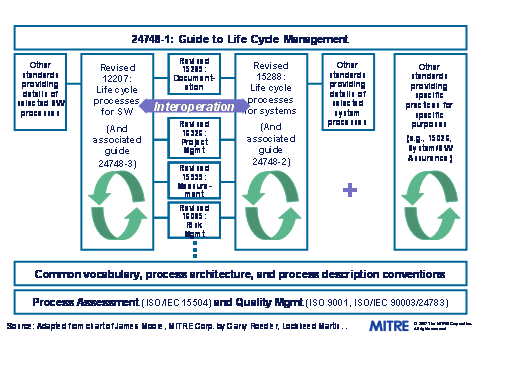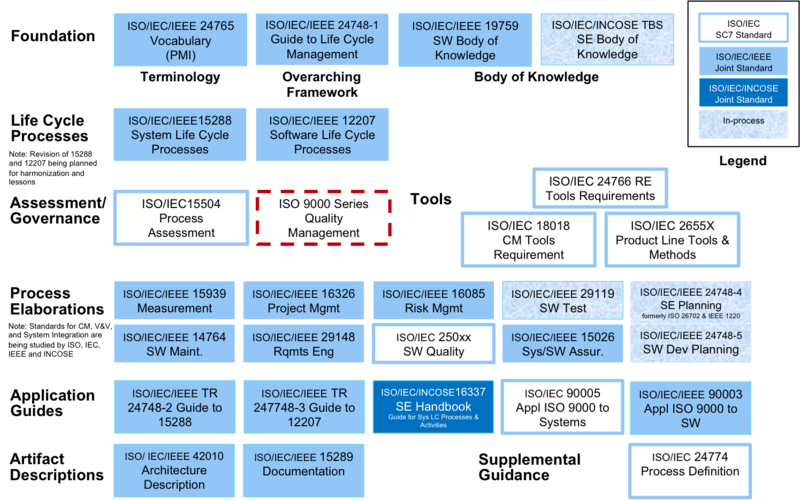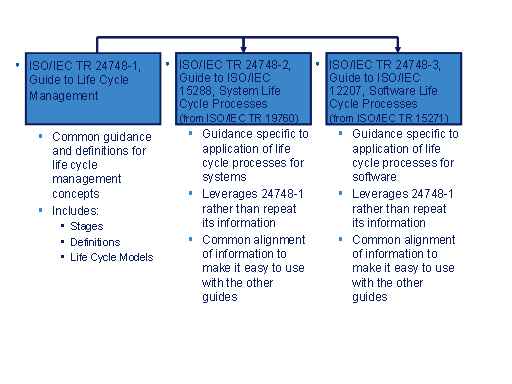Difference between revisions of "Alignment and Comparison of Systems Engineering Standards"
| Line 82: | Line 82: | ||
===Additional References=== | ===Additional References=== | ||
All additional references should be listed in alphabetical order. | All additional references should be listed in alphabetical order. | ||
| − | |||
See additional references in [[Relevant Standards for Systems Engineering]]. | See additional references in [[Relevant Standards for Systems Engineering]]. | ||
| + | |||
| + | ---- | ||
====Article Discussion==== | ====Article Discussion==== | ||
Revision as of 03:30, 19 August 2011
Introduction
Over the past decade, a number of the standards development organizations (SDOs) and other industry associations have been working collaboratively to align the systems and software engineering standards. The objective is to have a set of standards that can easily be used concurrently due to their use of common terminology and concepts.
Problem
There has been a lack of integration both within and across SDOs. This has led to Systems and Software engineering standards that have different terminology, process sets, process structures, levels of prescription, and audiences. These differences have been both between Systems and Software, and to some extent within each. The problem has been exacerbated by competing standards, in whole or part. (Roedler 2010)
Cause
The cause of this problem includes several factors, as follows:
- Culture - “We’re different”; “Not invented here”
- Organizational - Different teams, committees, etc.
- Competition - Many Standards Development Organizations
- Domains - Focused, narrow view often doesn’t look beyond the domain for commonality
(Roedler 2010)
Impact
The impact of this problem includes the following:
- Less effective or efficient processes that are not focused on leveraging commonalities. This causes redundancy and has resulted in incompatibilities, inconsistencies between the standards making it difficult to concurrently use them together.
- Less effective solutions that are not focused on a common approach to solve a problem or need.
- Obstacle for communicating (at all levels – disciplines, teams, etc.). working in integrated teams, and leveraging resources.
- Stove-piping due to the incompatibilities, inconsistencies, and lack of leveraging commonalities.
(Roedler 2010)
Objective
The objective is to make the standards more usable together by achieving:
- Common vocabulary
- Single, integrated process set
- Single process structure
- Jointly planned level of prescription
- Suitable across the audiences
- Accounts for considerations in wide range of domains and applications
(Roedler 2010)
Alignment of Systems Engineering Standards
Approach
A collaborative effort has been in place for the past decade that includes ISO/IEC JTC1/SC7 (Information Technology, Systems and Software Engineering), IEEE Computer Society, the International Council on Systems Engineering (INCOSE), and others. Figure XA depicts the approach being used to align the standards through this collaboration. It is built around a foundational set of vocabulary, process definition conventions, and life cycle management concepts provided by ISO/IEC/IEEE 24765 (Systems and software engineering vocabulary), ISO/IEC TR 24774 (Guidelines for process description), and ISO/IEC/IEEE TR 24748-1 (Guide to life cycle management), respectively. At the heart of the approach is the alignment of the ISO/IEC/IEEE 15288 (System life cycle processes) and ISO/IEC/IEEE 12207 (Software life cycle processes), which provide the top level process framework for life cycle management of systems and software. This enables concurrent and consistent use of the standards to support both systems and software life cycle management on a single project. The approach includes the development or revision of a set of lower level supporting standards and technical reports for elaboration of specific processes, description of practices for specific purposes (e.g., systems/software assurance), description of artifacts, and guidance for the application of the standards,
Figure 2 - Approach for Systems and Software Standards Alignment (Source: Roedler 2010)
Past Accomplishments
Significant progress has been made towards the alignment objectives for the groups discussed above. Figure 3 shows a May 2011 snapshot of the status of the standards that are being aligned. In addition, four of the standards shown as “In-process” are complete, but waiting for final publication. The set of standards span ISO/IEC, IEEE, INCOSE, and PMI. This figure depicts the standards in one of many possible taxonomies.
Figure 3 - Standards Alignment Results as of May 2011 (Source: Roedler 2010)
Current Efforts
A Life Cycle Process Harmonization Advisory Group has been evaluating the current standards for systems and software engineering. The objective of the group is to provide a set of recommendations for further harmonization of the industry standards. Specifically, its charter includes:
- Perform an architectural analysis and recommend a framework for an integrated set of process standards in software and IT systems domains
- Make recommendations regarding the future content, structure and relationships of ISO/IEC 12207, ISO/IEC 15288 and their guides, as well as other related SC 7 documents
To support the development of the recommendations, process modeling of ISO/IEC/IEEE 15288 and ISO/IEC/IEEE 12207 has been performed and analyzed for consistency, completeness/gaps, and opportunities. In addition, analysis from other working groups, technical liaisons and users of the standards has been collected. The output of this effect will be a harmonization strategy, set of recommendations for specific standards, and timing/sequencing recommendations. (Roedler 2011)
Comparison of Systems Engineering Standards
Figure 1 (Relevant Standards for Systems Engineering article) shows the breadth and level of detail for many of the SE related standards. Since EIA 632 (Engineering of a System) is currently in revision, a comparison of ISO/IEC/IEEE 15288 (System life cycle processes) and EIA 632, will be deferred until the revision is complete.
Figure 4 shows a comparison of the 3-part technical reports that provide life cycle management guidance. Part 1 is focused on the provision of common terminology and concepts that apply to both systems and software. Part 2 provides guidance that directly supports ISO/IEC/IEEE 15288 that is specific to systems. And Part 3 provides guidance that directly supports ISO/IEC/IEEE 12207 that is specific to software. (Roedler 2010)
Figure 4 - Standards Alignment Results as of May 2011 (Source: Roedler 2010)
Linkages to Other Systems Engineering Topics
This topic has linkages to the most of the SE topics, since the set of sets in Table 1 include cover most of the SE activities. Thus, specific linkages are not provided.
Practical Considerations
Key pitfalls and good practices related to systems engineering standards are described in the next two sections.
Pitfalls
See Pitfalls described in Relevant Standards for Systems Engineering
Good Practices
See Pitfalls described in Relevant Standards for Systems Engineering
References
Please make sure all references are listed alphabetically and are formatted according to the Chicago Manual of Style (15th ed). See the BKCASE Reference Guidance for additional information.
Citations
List all references cited in the article. Note: SEBoK 0.5 uses Chicago Manual of Style (15th ed). See the BKCASE Reference Guidance for additional information.
Primary References
All primary references should be listed in alphabetical order. Remember to identify primary references by creating an internal link using the ‘’’reference title only’’’ (title). Please do not include version numbers in the links.
See primary references in Relevant Standards for Systems Engineering.
Additional References
All additional references should be listed in alphabetical order.
See additional references in Relevant Standards for Systems Engineering.


